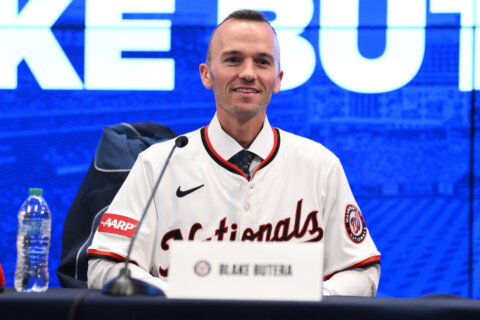WASHINGTON — Injuries happen frequently in professional sports, especially minor ones. Every player in a Major League clubhouse gets treatment for any number of bumps and bruises over the course of 162 games. But teams rely upon the correct diagnoses of the severity of such injuries to ensure their highly-paid talent is protected, and to make certain that they have the right personnel available at the big league level to not give games away.
For all the things the Washington Nationals baseball operations department has done well in acquiring a talent pool that has led many experts to pick them to win the World Series three years running, their underreporting and management of injury issues has been curiously poor. The former issue frustrates fans and supporters, but the latter has been, and threatens to continue to be, a stumbling block between the organization and its championship goals.
Perhaps the most disconcerting of such issues for Nats fans is the curious case of Anthony Rendon. The budding superstar led the National League in runs in 2014, slapping 66 extra-base hits and playing stellar defense as third base en route to a top five National League MVP finish.
However, Rendon also has a troubling history of lower leg injuries, requiring a pair of right ankle surgeries in college, then badly spraining and slightly fracturing his left ankle in just his second professional game back in 2012. Given that history, along with a shoulder injury that hampered his senior season at Rice, one might expect any injury concern to be treated particularly cautiously, with conservative timetables set for a return.
Here’s what has happened since March 9, when a seemingly innocuous diving stop has led to a series of health reports alternating between hopeful and regressive. Now, the infielder’s rehab process has been stalled until further notice, with no firm timetable set for his return to the Major Leagues.
Rendon banged his left knee making that ridiculous diving stop on Monday, has some swelling. Scratch is "Purely precautionary" Williams says
— Chelsea Janes (@chelsea_janes) March 11, 2015
Important injury to watch. RT @chelsea_janes: Rendon will be out a few days with MCL sprain in left knee. No procedure necessary. Just rest.
— James Wagner (@ByJamesWagner) March 13, 2015
Each must clear hurdles, Matt believes Escobar (oblique) & Rendon (knee) will be ready for opener. Rendon doing weight-bearing exercises.
— James Wagner (@ByJamesWagner) March 20, 2015
Anthony Rendon's knee remains sore, esp. when hitting. Matt said plan is still rest. Rendon may run out of time to be ready for opening day.
— James Wagner (@ByJamesWagner) March 23, 2015
Rendon doesn't know if he'll be ready for April 6. When doing rotational exercises, Rendon felt it. "Wasn't staggering pain." So he stopped.
— James Wagner (@ByJamesWagner) March 25, 2015
James Andrew's diagnosis of Rendon confirmed Nats': sprained MCL & knee is stable. He'll need rest. Seeing Dr. Steve Singleton in Vail next.
— James Wagner (@ByJamesWagner) March 31, 2015
Williams on Rendon's progress, which has been slow: "It could turn quickly." http://t.co/OYcsiyBa8P
— Chelsea Janes (@chelsea_janes) April 9, 2015
Anthony Rendon played 3 innings in extended ST in Viera today. Down for 5 innings tomorrow, then an offday & start of a rehab assignment.
— James Wagner (@ByJamesWagner) April 21, 2015
The update on Anthony Rendon, who is on a path to possibly make his season debut late next week in New York: http://t.co/0dnbHwHSmY
— Mark Zuckerman (@MarkZuckerman) April 22, 2015
Anthony Rendon scratched from Harrisburg lineup. Team says he was "fatigued today," and that they are "taking a cautious course of action."
— Chelsea Janes (@chelsea_janes) April 27, 2015
Anthony Rendon, scratched last minute last night because of his knee, is not in Class AA Harrisburg's lineup tonight either.
— James Wagner (@ByJamesWagner) April 28, 2015
Quote from Rizzo on Rendon: "The knee is fine. The side doesn't really worry us, but it's something that you can't really just ignore"
— Chelsea Janes (@chelsea_janes) April 29, 2015
And if all goes well, Rendon could be back with Nats near end of next week.
— James Wagner (@ByJamesWagner) May 2, 2015
Anthony Rendon has an oblique strain, Matt Williams said. Severity and specific timetable unclear now. But he's going to rest more.
— James Wagner (@ByJamesWagner) May 5, 2015
MRI shows oblique strain for Rendon. Shut down til it heals.
— Mark Zuckerman (@MarkZuckerman) May 5, 2015
The problem is that Rendon’s underreported diagnosis is hardly an isolated incident. $210 million acquisition Max Scherzer’s jammed thumb was “not considered serious” until he missed his next start, pushed back an extra three days. In a more major turn, reliever Craig Stammen went from having positive results on stress tests on April 15, to a torn flexor tendon that cost him the entire season the very next day.
Jayson Werth has suddenly missed two straight games with a “cranky and sore” surgically repaired shoulder. In 85 plate appearances, the soon-to-be 36-year-old has grounded into as many double plays as he has notched extra-base hits (two each). While Werth has posted slightly lower April numbers throughout his career (.259/.347/.433), there is nothing to suggest this is a normal, slow start. He’s slugging just .203, which would rate as the worst mark in baseball if he had enough plate appearances to qualify.
And yet, Werth’s surgery didn’t take place until Jan. 9, 94 days after Washington’s 2014 season ended in San Francisco. It was an injury he was well aware of in the second half of 2014, and even receive two cortisone shots for, missing a week in August.
On Tuesday, Stephen Strasburg exited after just three innings with some form of self-reported alignment issue, initially reported not to be a shoulder or elbow problem, the more serious type of injury all pitchers strive to avoid. He was slated to see a doctor Wednesday, but no reports of any test results have been reported as of press time.
From a reporting side, these issues go back to at least 2012, so they can’t be blamed on manager Matt Williams, who did not arrive until the offseason before the 2014 campaign. In 2012, Ryan Zimmerman’s shoulder bothered him enough to sit a few days near the end of April, but there was no reported damage. Within a week, Zimmerman landed on the DL, and by the end of the season he would have the same surgery as Werth did this past offseason. His arm has never been the same. Once a Gold Glove third baseman, he has moved permanently over to first base because of his inability to throw the ball across the infield.
In 2013, Bryce Harper injured his left knee crashing into the Dodger Stadium wall on May 13. He missed just one day at the time, continuing to play until May 26. He was finally rested on May 27, but word was that there was no structural damage and that he was only going to miss a “couple of days.” On June 3, he was placed on the 15-day disabled list (retroactive to May 27) and did not return for nearly another month, next appearing on July 1.
After the season, Harper needed surgery to remove part about 10 percent of the bursa, never fully recovering until after the procedure.
So what in the world is going on in the training room at 1500 South Capitol Street SE? To begin to answer, it’s important to dispel with a few common misconceptions regarding the language baseball uses when reporting injuries in the first place.
The term “day-to-day” can be misleading. It doesn’t necessarily mean that a player should only be expected to be out a day or two, but rather that an injury isn’t deemed sever enough to pull the trigger immediately on a disabled list stint, which automatically relegates a player from the roster for 15 days. The ability to backdate such assignments retroactively gives teams more leeway in making that decision, so that they don’t need to rush.
Dr. Andrew Cosgarea is the director of sports medicine and head team physician for Johns Hopkins athletics. He was also a team doctor for the Baltimore Orioles for 10 years.
“It’s the physician’s obligation, first and foremost, to inform the athlete,” he says. “If an athlete is an employee of the organization, part of the employment arrangement is to have that information shared with the company.”
But is it the organization’s job to disseminate that information to its fans and the general public? The original reason behind Reds’ manager Bryan Price’s expletive-laced tirade was his disgust with every piece of injury news being reported in the public forum. After all, might there be a competitive advantage to underreporting an injury?
“That’s pretty obvious, isn’t it?” says Cosgarea, but couches his statement with the caveat that such misinformation is highly unlikely to come from any medical staff. “In my experience, doctors and trainers give the best information they can to the organization about their players.”
The question then becomes whether the information that is shared publicly, usually through the manager, is the whole truth. Hockey is infamous for its upper or lower body injuries — labels designed to be intentionally vague. Even with the Wizards specifically detailing John Wall’s five non-displaced hand and wrist fractures on Thursday, they did not rule him out for Saturday’s Game 3 against the Atlanta Hawks.
“I think, in general, organizations spend a lot of time thinking about what information they are going to provide for fans,” says Cosgarea. “They don’t want fans to feel like information is being withheld. In my experience, organizations try to include fans in their happiness, their great news, and in their disappointments.”
Nevertheless, there seems to be an endemic reporting issue when it comes to injuries in the organization. This would seem to be either an issue of the medical staff misdiagnosing the severity of trauma, or of the powers that disseminate such information publicly underselling its nature and consequence.
It has clearly strained credulity with the fans, as can be seen in the replies to many of the tweets above. The health paradigm is seldom as public as it is in professional sports, one of the only arenas in our society that puts medical information on display for all to see. Perhaps that has contributed to the exacerbation of frustration among the fan base in regard to the health of their team.
“When things turn out the way they are expected to turn out, nobody says anything,” says Cosgarea. “Most of the time, they’re right in their diagnoses, sometimes they are not. That may make it appear that information is being withheld when it’s not.”






